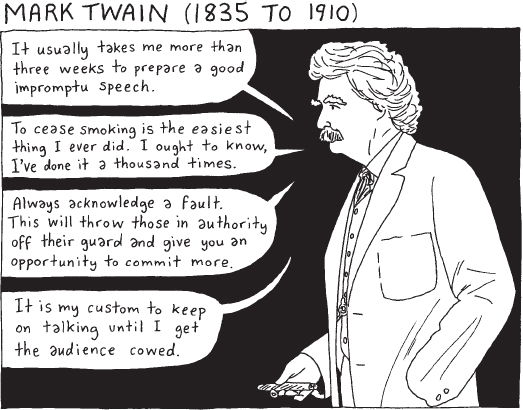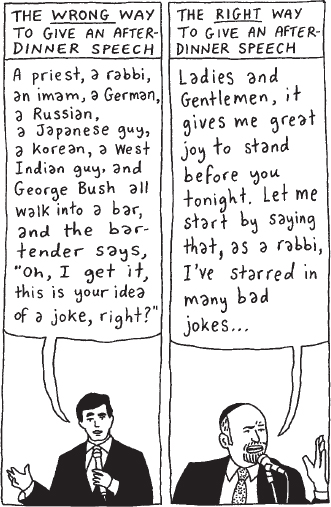Strategies for After-Dinner Speeches
Printed Page 608
After-dinner speeches have a long and storied tradition in the United States, emerging in an age before television and other mass media were on the scene and when speaking was therefore a major form of entertainment. This tradition produced such literary giants as Mark Twain, who gave several hundred of these kinds of addresses, always after a meal.5 Like others who delivered these types of presentations, Twain usually salted his after-dinner speeches with entertaining stories, personal references, and a great deal of wit.
After-dinner speeches in the United States have developed their own unique flavor, but other cultures have their own after-dinner speaking traditions. Some scholars argue that the North American style of toasting arose from a long-standing tradition from Great Britain, centered in formal affairs and especially in traditional British men’s clubs. And Russia has a tradition of sharing many toasts—studded with anecdotes and stories for each drink—at formal occasions and especially at group meals.
Effective after-dinner speakers assume the role of entertainers and have a talent for amusing and delighting their audiences while occasionally making a more serious point. Indeed, many after-dinner speeches are given at gatherings designed to raise funds for a particular cause, such as a charitable organization or a politician’s election campaign. These speeches are longer and more involved than simple toasts, and they require the ability to thrill and captivate an audience, often after listeners have consumed a full meal and perhaps a few glasses of wine. To overcome these challenges, apply the following strategies for delivering an effective after-dinner speech.

Focus on Humorous Anecdotes and Narrative Delivery, Not Jokes. In after-dinner speeches, the tradition has always been to employ witty stories and anecdotes as opposed to a series of one-liners or jokes with punch lines. Remember that your after-dinner speech should be a combination of anecdotal references and storytelling wrapped around a larger theme, not a stand-up comedy routine.

Practice Your Storytelling and Narrative Delivery. The success of your after-dinner speech hinges just as much on how you tell a story as it does on what you say in the story itself. Sufficiently rehearse your narrative so that you will feel comfortable and relaxed sharing it during the actual speech. Think of your after-dinner speech as a kind of performance, and understand that—like all performances—this one will benefit from lots of practice and polish.
Link Your Speech to the Occasion’s Theme. If the dinner gathering has a serious theme—for example, the importance of raising funds to support cancer research—consider linking a lighter narrative to that weightier theme. You’ll help the audience adopt a relaxed and receptive frame of mind while still accepting the urgency of the topic.
Adapt Your Delivery to Your Audience and the Occasion. Be prepared to make spontaneous adjustments to your structure and content based on what’s happening around you. Look for opportunities to focus your wit or good-natured satire on something that another speaker or a member of the audience has said. For example, by commenting on a point that a previous speaker made or a question that an audience member has asked, you show that you’re delivering an original rather than a canned or prepackaged speech. You thus let your audience know that you consider them worthy of a fresh presentation tailored specifically to them.
